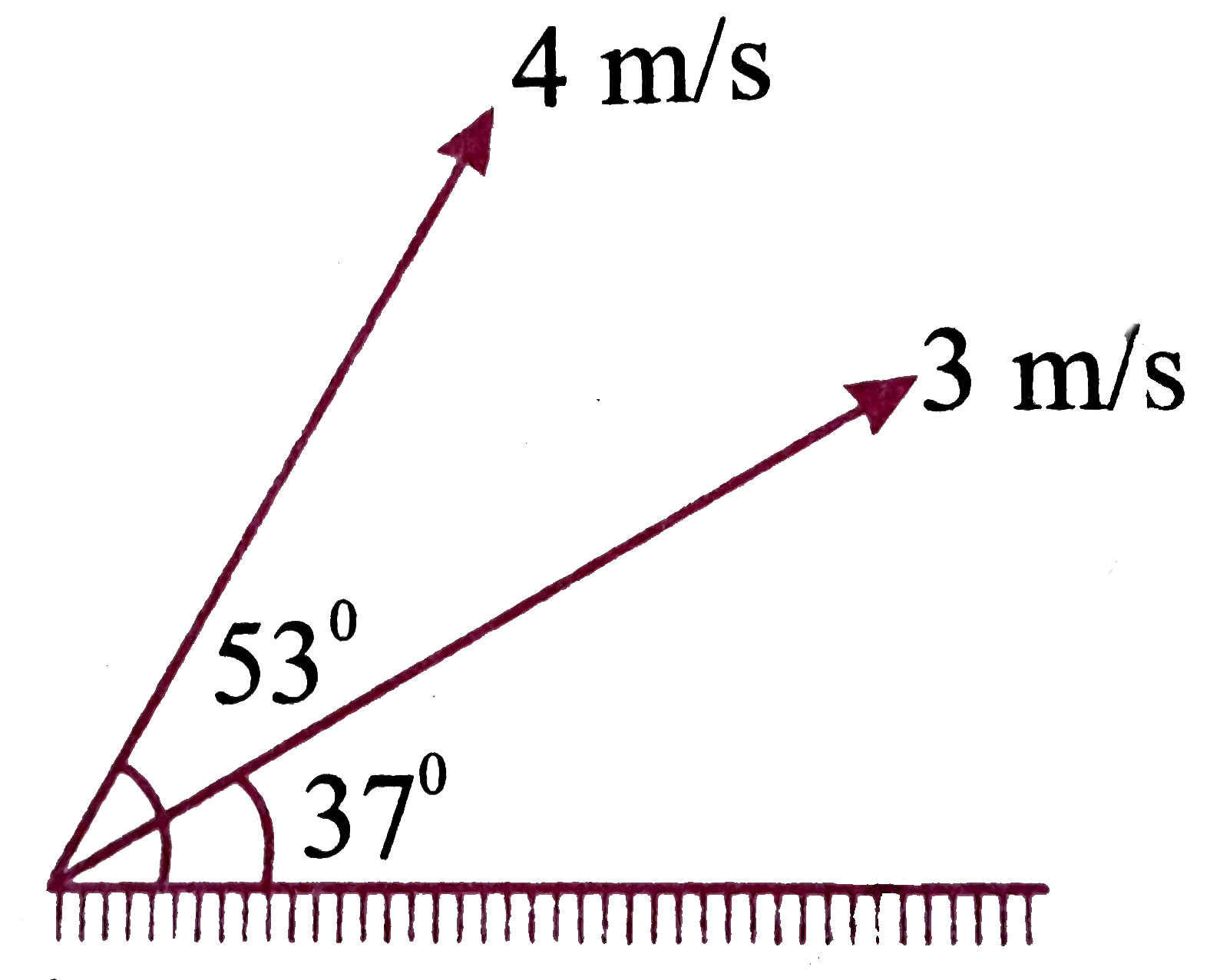Two particles A and B start moving simultaneously along the line joining them in the same direction with acceleration of 1m/s2and2m/s2 and speeds 3m/sand1m/s respectively. Initially, A is 10 m behind B. What is the minimum distance between them?
To solve the problem, we need to find the minimum distance between two particles A and B moving in the same direction with given initial speeds and accelerations. Here’s a step-by-step breakdown of the solution:
Step 1: Identify the initial conditions
- Particle A:
- Initial speed, uA=3m/s
- Acceleration, aA=1m/s2
- Particle B:
- Initial speed, uB=1m/s
- Acceleration, aB=2m/s2
- Initial distance between A and B: d=10m (A is behind B)
Step 2: Determine when the velocities are equal
To find the time when the minimum distance occurs, we set the velocities of A and B equal to each other using the equation of motion:
vA=uA+aAt
vB=uB+aBt
Setting vA=vB:
3+1t=1+2t
Rearranging gives:
3−1=2t−1t
2=t
Thus, t=2s.
Step 3: Calculate the distance traveled by each particle
Now we will calculate the distance traveled by both particles A and B in 2 seconds.
- Distance traveled by A:
SA=uAt+12aAt2
SA=3⋅2+12⋅1⋅(22)=6+12⋅1⋅4=6+2=8m
- Distance traveled by B:
SB=uBt+12aBt2
SB=1⋅2+12⋅2⋅(22)=2+12⋅2⋅4=2+4=6m
Step 4: Calculate the positions of A and B after 2 seconds
- Initial position of B is at 0 m (since A is 10 m behind).
- Position of A after 2 seconds:
Position of A=−10+SA=−10+8=−2m
- Position of B after 2 seconds:
Position of B=0+SB=0+6=6m
Step 5: Calculate the minimum distance
The minimum distance between A and B at t=2s:
Minimum Distance=Position of B−Position of A=6−(−2)=6+2=8m
Final Answer
The minimum distance between particles A and B is 8 meters.
---
- Particle A:
- Initial speed, uA=3m/s
- Acceleration, aA=1m/s2
- Particle B:
- Initial speed, uB=1m/s
- Acceleration, aB=2m/s2
To find the time when the minimum distance occurs, we set the velocities of A and B equal to each other using the equation of motion:
vA=uA+aAt
vB=uB+aBt
Setting vA=vB:
3+1t=1+2t
Rearranging gives:
3−1=2t−1t
2=t
Thus, t=2s.
Now we will calculate the distance traveled by both particles A and B in 2 seconds.
SA=uAt+12aAt2
SA=3⋅2+12⋅1⋅(22)=6+12⋅1⋅4=6+2=8m
SB=uBt+12aBt2
SB=1⋅2+12⋅2⋅(22)=2+12⋅2⋅4=2+4=6m
- Initial position of B is at 0 m (since A is 10 m behind).
- Position of A after 2 seconds:
Position of A=−10+SA=−10+8=−2m
- Position of B after 2 seconds:
Position of B=0+SB=0+6=6m
The minimum distance between A and B at t=2s:
Minimum Distance=Position of B−Position of A=6−(−2)=6+2=8m
The minimum distance between particles A and B is 8 meters.
Topper's Solved these Questions
- BOOK - DC PANDEY ENGLISHCHAPTER - KINEMATICSEXERCISE - Subjective50videos
KINEMATICS
- BOOK - DC PANDEY ENGLISHCHAPTER - KINEMATICSEXERCISE - More Than One Correct6videos
KINEMATICS
- BOOK - DC PANDEY ENGLISHCHAPTER - KINEMATICSEXERCISE - Assertion And Reason12videos
KINEMATICS
- BOOK - DC PANDEY ENGLISHCHAPTER - GRAVITATIONEXERCISE - (C) Chapter Exercises45videos
GRAVITATION
- BOOK - DC PANDEY ENGLISHCHAPTER - KINEMATICS 1EXERCISE - INTEGER_TYPE15videos
KINEMATICS 1
Similar Questions
Car A and car B start moving simultaneously in the same direction along the line joining them. Car A moves with a constant acceleration a=4m/s2, while car B moves with a constant velocity v=1m/s. At time t=0, car A is 10m behind car B. Find the time when car A overtake car B.
View SolutionTwo particles A and B are projected simultaneously in the directins shown in figure with velocities vA=20m/sandvB=10m/s respectively. They collide in air after 12 s. Find
(a) the angle θ
(b) the distance x.
 . View Solution
. View SolutionTwo objects of masses 100g and 200g are moving along the same line in the same direction with velocities of 2m/s and 1m/s, respectively. They collide and after the collison, the first object moves at a velocity of 1.67m/s in the same direction. Determine the velocity of the second object.
View SolutionA particle, initially at rest, starts moving in a straight line with an acceleration a=6t+4m/s2. The distance covered by it in 3 s is
View SolutionTwo particles are projected with speed 4m/s and 3m/s simultaneously from same point as shown in the figure. Then:
 View Solution
View SolutionTwo particles of mass 1 kg and 0.5 kg are moving in the same direction with speed of 2m/s and 6 m/s respectively on a smooth horizontal surface. The speed of centre of mass of the system is
View SolutionConsider
 .
.
The potential difference VA−VB is.View SolutionA particle of mass 2kg starts moving in a straight line with an initial velocity of 2m/s at a constant acceleration of 2m/s2. Then rate of change of kinetic energy.
View SolutionA particle starts moving with acceleration 2m/s2. Distance travelled by it in 5th half second is
View SolutionA particle starts from rest accelerates at 2m/s2 for 10s and then goes for constant speed for 30s and then decelerates at 4m/s2 till it stops. What is the distance travelled by it.
View Solution

